Usability of a Virtual Learning Environment in Down Syndrome Adult Learning
Abstract
:1. Introduction
Applying VLEs in Environments for Persons with Special Educational Needs
- RQ1.
- Will there be significant differences in the learning outcomes in the concepts of sustainability before and after the use of a VLE?
- RQ2.
- Will there be significant differences in the learning outcomes in the concepts of sustainability depending on students’ frequency of use of a VLE?
- RQ3.
- Will there be significant differences in the learning outcomes in the concepts of sustainability depending on the time students spend using a VLE?
- RQ4.
- Will there be different clusters amongst students vis à vis their learning behaviour in the VLE?
- RQ5.
- What will be the perceived student satisfaction with the thematic content and the VLE?
2. Materials and Methods
2.1. Participants
2.2. Instruments
- (a)
- Open access SusKids virtual learning environment https://suskids.bjaland.co/en/courses/ (26 November 2023). This platform was developed as part of the SusKids project co-funded by the European Commission. It involves working with concepts related to sustainable behaviour and is made up of four courses: Course 1. Environment, which in turn contains five thematic blocks (environment; air; the Earth and mountains; water and the oceans; and animals and plants). Course 2. Waste, which in turn contains three blocks (a description of waste; waste is a problem and what to do with waste). Course 3. What to do with waste? This in turn contains seven thematic blocks (where does waste go?; incinerators; dumps; reducing; recycling; review activities). Course 4. Construction and environment, which includes eight blocks (buildings; rocks; bricks, tiles and ceramics; cement; concrete; mortar; construction and environment; evaluation). Each course contains a progress bar.
- (b)
- Initial test of their knowledge of sustainability. One test per year was applied.
- (c)
- Raven’s progressive matrices test [46]. Evaluation test of the G factor of intelligence. Specifically, the Coloured Progressive Matrices Scale (CPM) was applied. This is designed to evaluate children aged four to nine or people with an intellectual deficit. The test has a test–retest reliability index of r = 0.82 and of α = 0.86
- (d)
- Adaptive Behaviour Assessment System II (ABAS-II) [47]. This scale evaluates the everyday functional skills required to operate independently in daily life. It analyses the areas of communication, use of community resources, functional academic skills, life in the home or life at school, health and safety, leisure, self-care, self-guidance, social, motor, and employment. It also provides the Global Index of Adaptive Behaviour (CAG). In its Spanish version, the test obtained an α = 0.91. In this study, the overall reliability index was α = 0.93.
- (e)
- Survey on perceived user satisfaction with the use of the VLE. An ad hoc questionnaire was designed, consisting of 12 closed-response items measured on a scale of 1 to 3 (ranging from 1 = not at all satisfied to 3 = very satisfied), and open-response questions addressing the strengths and weaknesses of the VLE (see Appendix A). The questionnaire obtained an α = 0.77 and Ω = 0.74 for the whole questionnaire, and an interval of α = 0.72- α = 0.78 and Ω = 0.67- Ω = 0.76 for the remaining elements.
2.3. Procedure
2.4. Data Analysis
2.5. Design
3. Results
3.1. Prior Analysis
3.2. Analysis of Hypothesis Testing
3.2.1. Differences in Learning Outcomes Before-after Instruction in VLE (RQ1)
3.2.2. Influence of Frequency Use of the Automatic Reader of the VLE and Learning Outcomes (RQ2)
3.2.3. Influence of Student Time Spent on the VLE and Learning Outcomes (RQ3)
3.2.4. Cluster Analysis (RQ4)
3.2.5. Perceived Student Satisfaction with the Usability of the VLE
4. Discussion
5. Conclusions
Future Lines of Work and Educational Implications
Author Contributions
Funding
Institutional Review Board Statement
Informed Consent Statement
Data Availability Statement
Acknowledgments
Conflicts of Interest
Appendix A
| Items | Scores | ||
| Closed questions | |||
| 1. Did you understand all of the content worked with in the VLE? | 1 | 2 | 3 |
| 2. Were the activities clear? | 1 | 2 | 3 |
| 3. Were the activities easy? | 1 | 2 | 3 |
| 4. Did you enjoy the activities? | 1 | 2 | 3 |
| 5. Was the work on the VLE easy? | 1 | 2 | 3 |
| 6. Would you have liked to learn other things in the VLE courses? | 1 | 2 | 3 |
| 7. Was it easy to stop inside an activity? | 1 | 2 | 3 |
| 8. Was it easy to move from one activity to another? | 1 | 2 | 3 |
| 9. Was it easy to return to an activity/do an activity again? | 1 | 2 | 3 |
| 10. Did you find the VLE attractive? | 1 | 2 | 3 |
| 11. Did you find the VLE clear? | 1 | 2 | 3 |
| 12. Would you like to change the appearance of the VLE? | 1 | 2 | 3 |
| Open questions | |||
| 13. What did you like most about the platform? | |||
| 14. What did you like least about the platform? | |||
Appendix B
Appendix B.1. Answers to Question 13: What Did You Like Most about the Platform?
Appendix B.2. Answers to Question 14: What Did You Like Least about the Platform?
References
- Malmberg, J.; Järvelä, S.; Järvenoja, H.; Panadero, E. Promoting Socially Shared Regulation of Learning in CSCL: Progress of Socially Shared Regulation Among High- and Low-Performing Groups. Comput. Hum. Behav. 2015, 52, 562–572. [Google Scholar] [CrossRef]
- García-Peñalvo, F.J. Digital Transformation in the Universities: Implications of the COVID-19 Pandemic. Educ. Knowl. Soc. 2021, 22, e25464. [Google Scholar] [CrossRef]
- Sáiz-Manzanares, M.C.; Marticorena-Sánchez, R.; Rodríguez-Díez, J.J.; Rodríguez-Arribas, S.; Díez-Pastor, J.F.; Ji, Y.P. Improve Teaching with Modalities and Collaborative Groups in an LMS: An Analysis of Monitoring Using Visualisation Techniques. J. Comput. High. Educ. 2021, 33, 747–778. [Google Scholar] [CrossRef] [PubMed]
- Sáiz-Manzanares, M.C.; Rodríguez-Díez, J.J.; Díez-Pastor, J.F.; Rodríguez-Arribas, S.; Marticorena-Sánchez, R.; Ji, Y.P. Monitoring of Student Learning in Learning Management Systems: An Application of Educational Data Mining Techniques. Appl. Sci. 2021, 11, 2677. [Google Scholar] [CrossRef]
- Dias, S.B.; Hadjileontiadou, S.J.; Diniz, J.A.; Hadjileontiadis, L.J. Computer-based Concept Mapping Combined with Learning Management System Use: An Explorative Study under the Self- and Collaborative-Mode. Comput. Educ. 2017, 107, 127–146. [Google Scholar] [CrossRef]
- Zimmerman, B.J.; Moylan, A.R. Self-regulation: Where Metacognition and Motivation Intersect. In Handbook of Metacognition in Education; Hacker, D.J., Dunlosky, J., Graesser, A.C., Eds.; Routledge/Taylor & Francis Group: New York, NY, USA, 2009; pp. 299–315. [Google Scholar]
- Azevedo, R.; Taub, M.; Mudrick, N. Technologies Supporting Self-regulated Learning. In Encyclopedia of Educational Technology; Spector, J.M., Ed.; SAGE Publications: Thousand Oaks, CA, USA, 2015; pp. 731–734. [Google Scholar]
- Gutiérrez, A.P.; Schraw, G. Effects of Strategy Training and Incentives on Students’ Performance, Confidence, and Calibration. J. Exp. Educ. 2015, 83, 386–404. [Google Scholar] [CrossRef]
- Azevedo, R.; Moos, D.C.; Johnson, A.M.; Chauncey, Á.D. Measuring Cognitive and Metacognitive Regulatory Processes during Hypermedia Learning: Issues and Challenges. Educ. Psychol. 2010, 45, 210–223. [Google Scholar] [CrossRef]
- Tugba Bulu, S.; Pedersen, S. Supporting Problem-solving Performance in a Hypermedia Learning Environment: The Role of Students’ Prior Knowledge and Metacognitive Skills. Comput. Hum. Behav. 2012, 28, 1162–1169. [Google Scholar] [CrossRef]
- Park, Y.; Jo, I.-H. Using Log Variables in a Learning Management System to Evaluate Learning Activity Using the Lens of Activity Theory. Assess. Eval. High. Educ. 2017, 42, 531–547. [Google Scholar] [CrossRef]
- Harks, B.; Rakoczy, K.; Hattie, J.; Besser, M.; Klieme, E. The Effects of Feedback on Achievement, Interest and Self-evaluation: The Role of Feedback’s Perceived Usefulness. Educ. Psychol. 2014, 34, 269–290. [Google Scholar] [CrossRef]
- Hattie, J.; Clarke, S. Visible Learning: Feedback; Routledge: London, UK, 2018. [Google Scholar] [CrossRef]
- Wisniewski, B.; Zierer, K.; Hattie, J. The Power of Feedback Revisited: A Meta-Analysis of Educational Feedback Research. Front. Psychol. 2020, 10, 3087. [Google Scholar] [CrossRef]
- Azevedo, R.; Gašević, D. Analyzing Multimodal Multichannel Data about Self-Regulated Learning with Advanced Learning Technologies: Issues and Challenges. Comput. Hum. Behav. 2019, 96, 207–210. [Google Scholar] [CrossRef]
- Malmberg, J.; Järvelä, S.; Holappa, J.; Haataja, E.; Huang, X.; Siipo, A. Going Beyond What Is Visible: What Multichannel Data Can Reveal about Interaction in the Context of Collaborative Learning? Comput. Hum. Behav. 2019, 96, 235–245. [Google Scholar] [CrossRef]
- Cloude, E.B.; Taub, M.; Lester, J.; Azevedo, R. The Role of Achievement Goal Orientation on Metacognitive Process Use in Game-Based Learning. In Artificial Intelligence in Education; Isotani, S., Millán, E., Ogan, A., Hastings, P., McLaren, B., Luckin, R., Eds.; Springer International Publishing: Cham, Switzerland, 2019; pp. 36–40. [Google Scholar] [CrossRef]
- Taub, M.; Mudrick, N.V.; Azevedo, R.; Millar, G.C.; Rowe, J.; Lester, J. Using Multi-Channel Data with Multi-Level Modeling to Assess In-Game Performance during Gameplay with CRYSTAL ISLAND. Comput. Hum. Behav. 2017, 76, 641–655. [Google Scholar] [CrossRef]
- Wiedbusch, M.D.; Kite, V.; Yang, X.; Park, S.; Chi, M.; Taub, M.; Azevedo, R. A Theoretical and Evidence-Based Conceptual Design of MetaDash: An Intelligent Teacher Dashboard to Support Teachers’ Decision Making and Students’ Self-Regulated Learning. Front. Educ. 2021, 6, 570229. [Google Scholar] [CrossRef]
- Cerezo, R.; Sánchez-Santillán, M.; Paule-Ruiz, M.P.; Núñez, J.C. Students’ LMS Interaction Patterns and their Relationship with Achievement: A Case Study in Higher Education. Comput. Educ. 2016, 96, 42–54. [Google Scholar] [CrossRef]
- Bannert, M.; Reimann, P.; Sonnenberg, C. Process Mining Techniques for Analysing Patterns and Strategies in Students’ Self-regulated Learning. Metacognition Learn. 2014, 9, 161–185. [Google Scholar] [CrossRef]
- Li, L.-Y.; Tsai, C.-C. Accessing Online Learning Material: Quantitative Behavior Patterns and their Effects on Motivation and Learning Performance. Comput. Educ. 2017, 114, 286–297. [Google Scholar] [CrossRef]
- Mudrick, N.V.; Azevedo, R.; Taub, M. Integrating Metacognitive Judgments and Eye Movements Using Sequential Pattern Mining to Understand Processes Underlying Multimedia Learning. Comput. Hum. Behav. 2019, 96, 223–234. [Google Scholar] [CrossRef]
- Sáiz-Manzanares, M.C.; Marticorena Sánchez, R.; García Osorio, C.I.; Díez-Pastor, J.F. How Do B-learning and Learning Patterns Influence Learning Outcomes? Front. Psychol. 2017, 8, 745. [Google Scholar] [CrossRef]
- Carbonero, M.A.; Román, J.M.; Ferrer, M. Programa para “aprender estratégicamente” con estudiantes universitarios: Diseño y validación experimental. An. Psicol. 2013, 29, 876–885. [Google Scholar] [CrossRef]
- Reoyo, N.; Carbonero, M.A.; Martín, L.J. Características de eficacia docente desde las perspectivas del profesorado y futuro profesorado de secundaria. Rev. Educ. 2017, 376, 62–86. [Google Scholar] [CrossRef]
- Taub, M.; Azevedo, R.; Rajendran, R.; Cloude, E.B.; Biswas, G.; Price, M.J. How Are Students’ Emotions Related to the Accuracy of Cognitive and Metacognitive Processes during Learning with an Intelligent Tutoring System? Learn. Instr. 2021, 72, 101200. [Google Scholar] [CrossRef]
- Martín-Antón, L.J.; Aramayo-Ruiz, K.P.; Rodríguez-Sáez, J.L.; Sáiz-Manzanares, M.C. Procrastination in Pre-service Teachers: The Role of Learning Strategies and Academic Achievement. Educ. XX1 2022, 25, 65–88. [Google Scholar] [CrossRef]
- Cerezo, R.; Esteban, M.; Sánchez-Santillán, M.; Núñez, J.C. Procrastinating Behavior in Computer-Based Learning Environments to Predict Performance: A Case Study in Moodle. Front. Psychol. 2017, 8, 1403. [Google Scholar] [CrossRef]
- Greig, A.; Priddle, J. Mapping Students’ Development in Response to Sustainability Education: A Conceptual Model. Sustainability 2019, 11, 4324. [Google Scholar] [CrossRef]
- Al-Ansi, A.M.; Jaboob, M.; Garad, A.; Al-Ansi, A. Analyzing augmented reality (AR) and virtual reality (VR) recent development in education. Soc. Sci. Humanit. Open 2023, 8, 100532. [Google Scholar] [CrossRef]
- Sáiz-Manzanares, M.C.; Ramos Pérez, I.; Arnaiz-Rodríguez, Á.; Rodríguez-Arribas, S.; Almeida, L.; Martín, C.F. Analysis of the learning process through eye tracking technology and feature selection techniques. Appl. Sci. 2021, 6157, 6157. [Google Scholar] [CrossRef]
- Qaffas, A.A.; Kaabi, K.; Shadiev, R.; Essalmi, F. Towards an Optimal Personalization Strategy in MOOCs. Smart Learn. Environ. 2020, 7, 14. [Google Scholar] [CrossRef]
- Sáiz-Manzanares, M.C.; Gutiérrez-González, S.; Rodríguez, Á.; Alameda Cuenca-Romero, L.; Calderón, V.; Queiruga-Dios, M.Á. Systematic Review on Inclusive Education, Sustainability in Engineering: An Analysis with Mixed Methods and Data Mining Techniques. Sustainability 2020, 12, 6861. [Google Scholar] [CrossRef]
- Hurwitz, S.; Garman-McClaine, B.; Carlock, K. Special Education for Students with Autism During the COVID-19 Pandemic: Each Day Brings New Challenges. Autism 2022, 26, 889–899. [Google Scholar] [CrossRef]
- Sokolikj, Z.; Ke, F.; Chakraborty, S.; Moon, J. Using Deep Learning to Track Representational Flexibility Development of Children with Autism in a Virtual World. In Proceedings of the 11th International Conference on Information and Education Technology (ICIET), Fujisawa, Japan, 18–20 March 2023; pp. 51–55. [Google Scholar] [CrossRef]
- Dos Santos Dourado, G.; Silva, J.A.O.S.; Di Menezes, A.R.C.; Silva, K.C.R.; De Souza Hannum, J.S.; De Andrade Barbosa, T.M.G. An AR Sand play System for People with Down Syndrome. In Proceedings of the 2019 IEEE MIT Undergraduate Research Technology Conference (URTC 2019), Cambridge, MA, USA, 11–13 October 2019; pp. 1–4. [Google Scholar] [CrossRef]
- Ma, L.; Yu, Q.; Huang, J.; Sun, Y. Based on the Exploration of VR in the Teaching and Training of Special Children. In Proceedings of the 3rd International Conference on Education Development and Studies, Hilo, HI, USA, 9–11 March 2022; pp. 37–41. [Google Scholar] [CrossRef]
- Bonilla-Del-Río, M.; Sánchez-Calero, M.L. Educational Inclusion in Times of COVID-19: Use of Social Media for People with Intellectual Disabilities. RIED-Rev. Iberoam. Educ. Distancia 2022, 25, 141–161. [Google Scholar] [CrossRef]
- Dharmarathne, R.S.C.K.; Medagedara, K.A.; Madhubashinee, N.B.W.N.; Maitipe, P.T.; Sriyaratna, D.; Abeywardena, K. STEP UP: Systematically Motivating the Children with Low Psychological Maturity Level and Disabled Children Using Gamification and Human Computer Interaction. In Proceedings of the 7th International Conference for Convergence in Technology (I2CT), Pune, India, 7–9 April 2022; pp. 1–6. [Google Scholar] [CrossRef]
- Barron, T.; Friend, M.; Dieker, L.; Kohnke, S. Co-Teaching in Uncertain Times: Using Technology to Improve Student Learning and Manage Today’s Complex Educational Landscape. J. Spec. Educ. Technol. 2021, 37, 439–446. [Google Scholar] [CrossRef]
- Reyes, J.I.; Meneses, J.; Melián, E. A Systematic Review of Academic Interventions for Students with Disabilities in Online Higher Education. Eur. J. Spec. Needs Educ. 2021, 37, 569–586. [Google Scholar] [CrossRef]
- Aguagallo, L.; Salazar-Fierro, F.; García-Santillán, J.; Posso-Yépez, M.; Landeta-López, P.; García-Santillán, I. Analysis of Student Performance Applying Data Mining Techniques in a Virtual Learning Environment. Int. J. Emerg. Technol. Learn. iJET 2023, 18, 175–195. [Google Scholar] [CrossRef]
- Colpo, M.P.; Primo, T.T.; de Aguiar, M.S. Lessons learned from the student dropout patterns on COVID-19 pandemic: An analysis supported by machine learning. Br. J. Educ. Technol. 2023, 1–26. [Google Scholar] [CrossRef]
- de Miranda, A.; da Silva, M.L.L.; da Silva, J.R.A.; Correia, A.A.; de Oliveira Rodrigues, C.M.; Lins, F.A.A.; de Oliveira Nobrega, O.; Falcao, T.P. E-Down: Uma Metodologia para Apoio à Escolha e Configuração de AVAs na formação de estudantes com Síndrome de Down. In Proceedings of the 2013 18th Iberian Conference on Information Systems and Technologies, Aveiro, Portugal, 20–23 June 2023. [Google Scholar] [CrossRef]
- Raven, J.C. Manual de RAVEN. Matrices Progresivas. CPM-SPM-APM (B*); [RAVEN Manual. Progressive Matrices]; Pearson-Clinical: London, UK, 2011. [Google Scholar]
- Harrison, P.L.; Oakland, T. Sistema de Evaluación de la Conducta Adaptativa ABAS-II. [Adaptive Behavior Assessment System. 2005], 2nd ed.; Montero Centeno, D.; Fernández-Pinto, I., Translators; TEA: Madrid, Spain, 2013. [Google Scholar]
- Cohen, J. Statistical Power Analysis. Curr. Dir. Psychol. Sci. 1992, 1, 98–101. [Google Scholar] [CrossRef]
- Hedges, L.V. Distribution Theory for Glass’s Estimator of Effect size and Related Estimators. J. Educ. Stat. 1981, 6, 107–128. [Google Scholar] [CrossRef]
- IBM Corp. SPSS Statistical Package for the Social Sciences (SPSS), Version 28; IBM Corp.: Armonk, NY, USA, 2022. [Google Scholar]
- Demsar, J.; Curk, T.; Erjavec, A.; Gorup, C.; Hocevar, T.; Milutinovic, M.; Mozina, M.; Polajnar, M.; Toplak, M.; Staric, A.; et al. Orange: Data Mining Toolbox in Python. J. Mach. Learn. Res. 2013, 14, 2349–2353. [Google Scholar]
- ATLAS.ti Corp. Software Package Qualitative Data Analysis; Version 22; ATLAS.ti Corp: Berlin, Germany, 2022. [Google Scholar]
- Campbell, D.F.; Stanley, J. Diseños Experimentales y Cuasiexperimentales en la Investigación Social, 9th ed.; Amorrortu: Buenos Aires, Argentina, 2005. [Google Scholar]
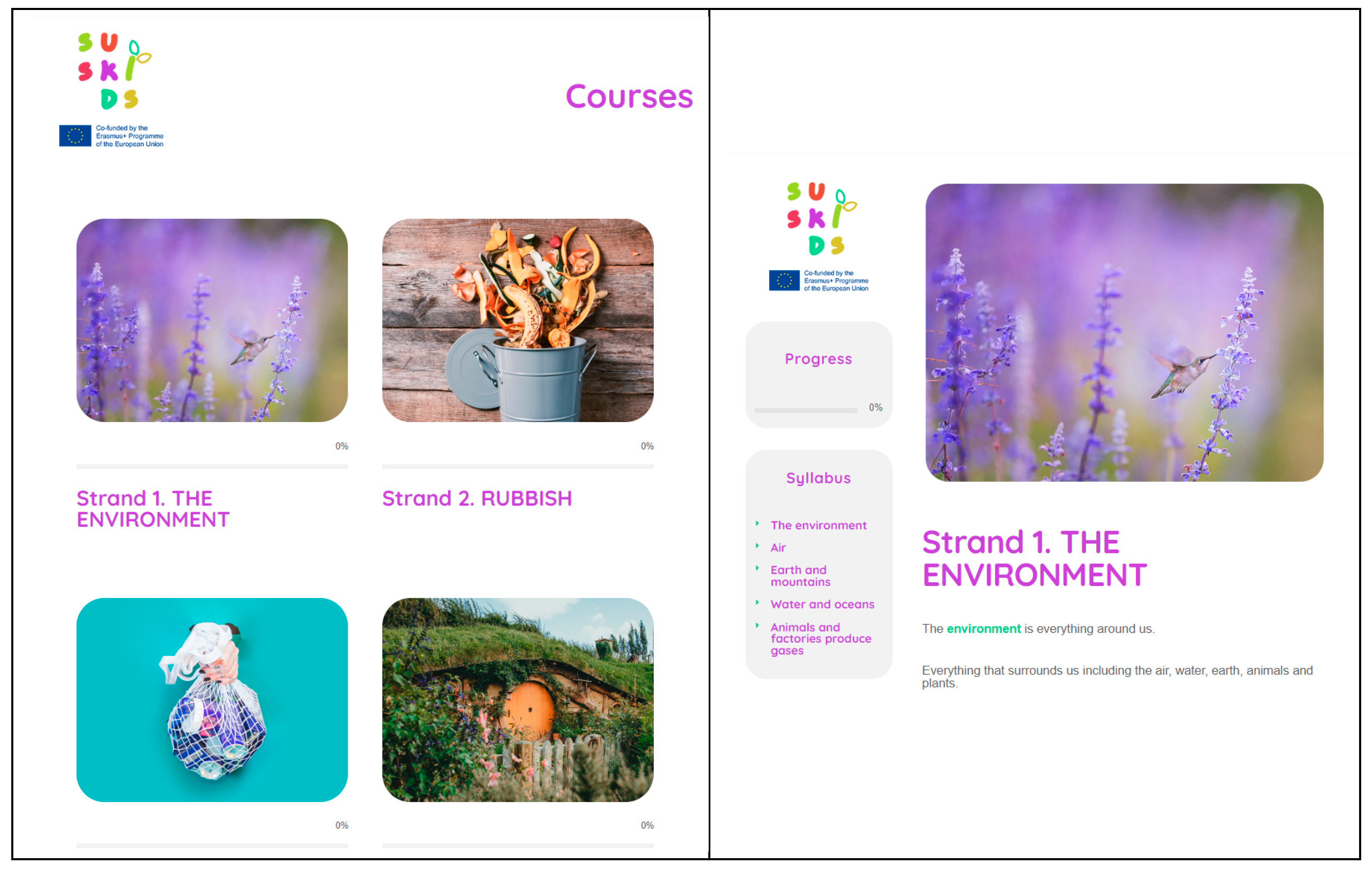
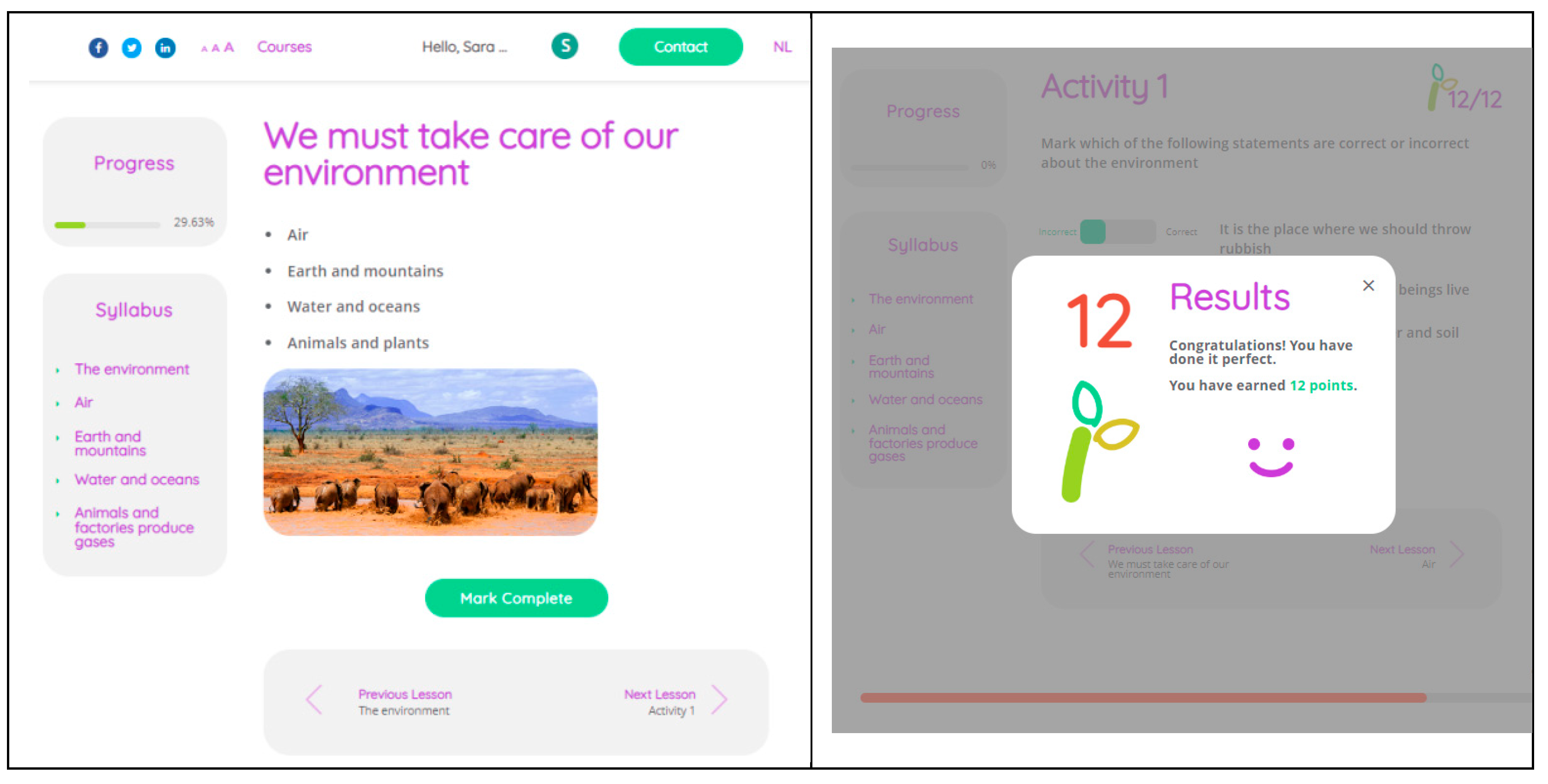

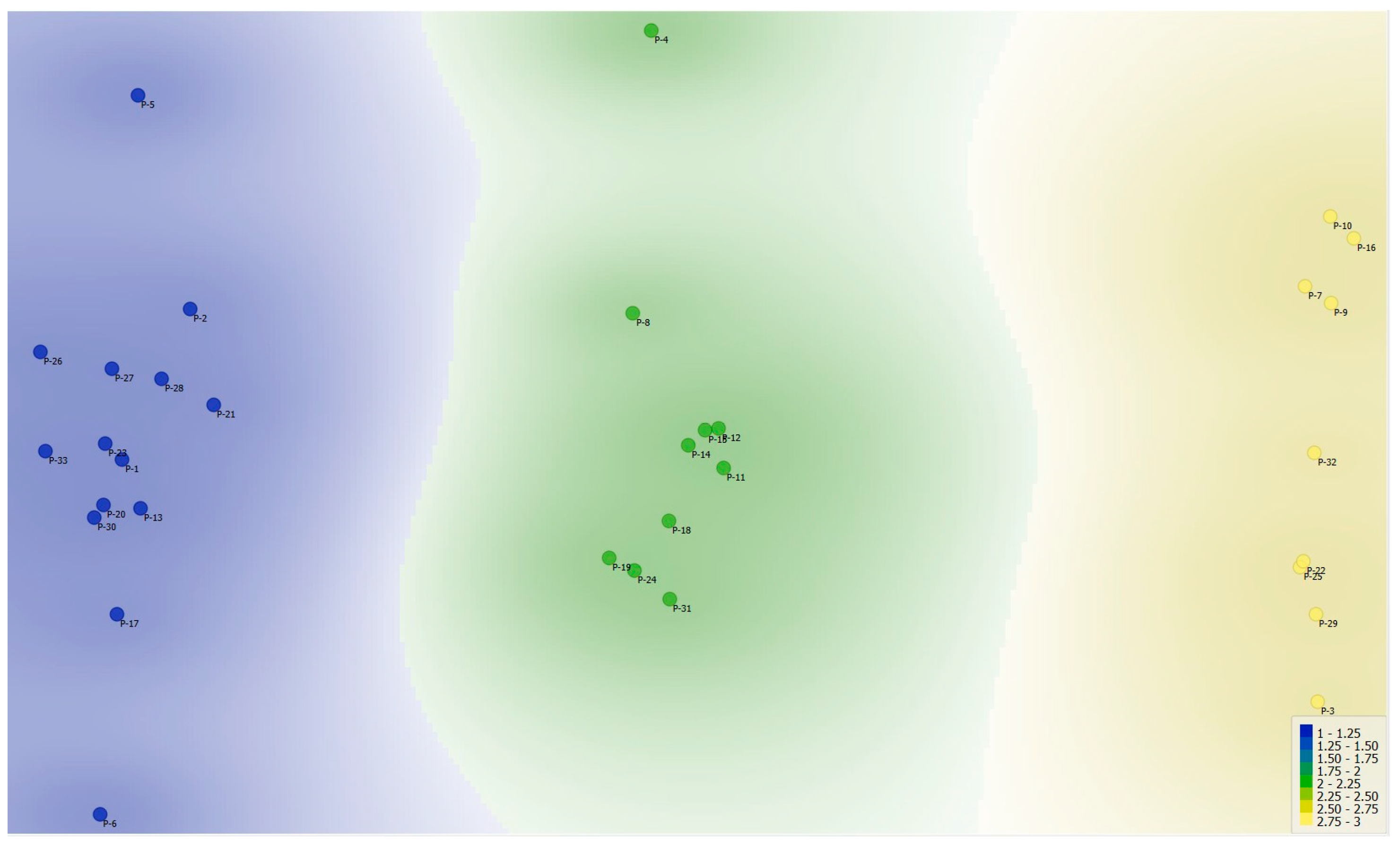
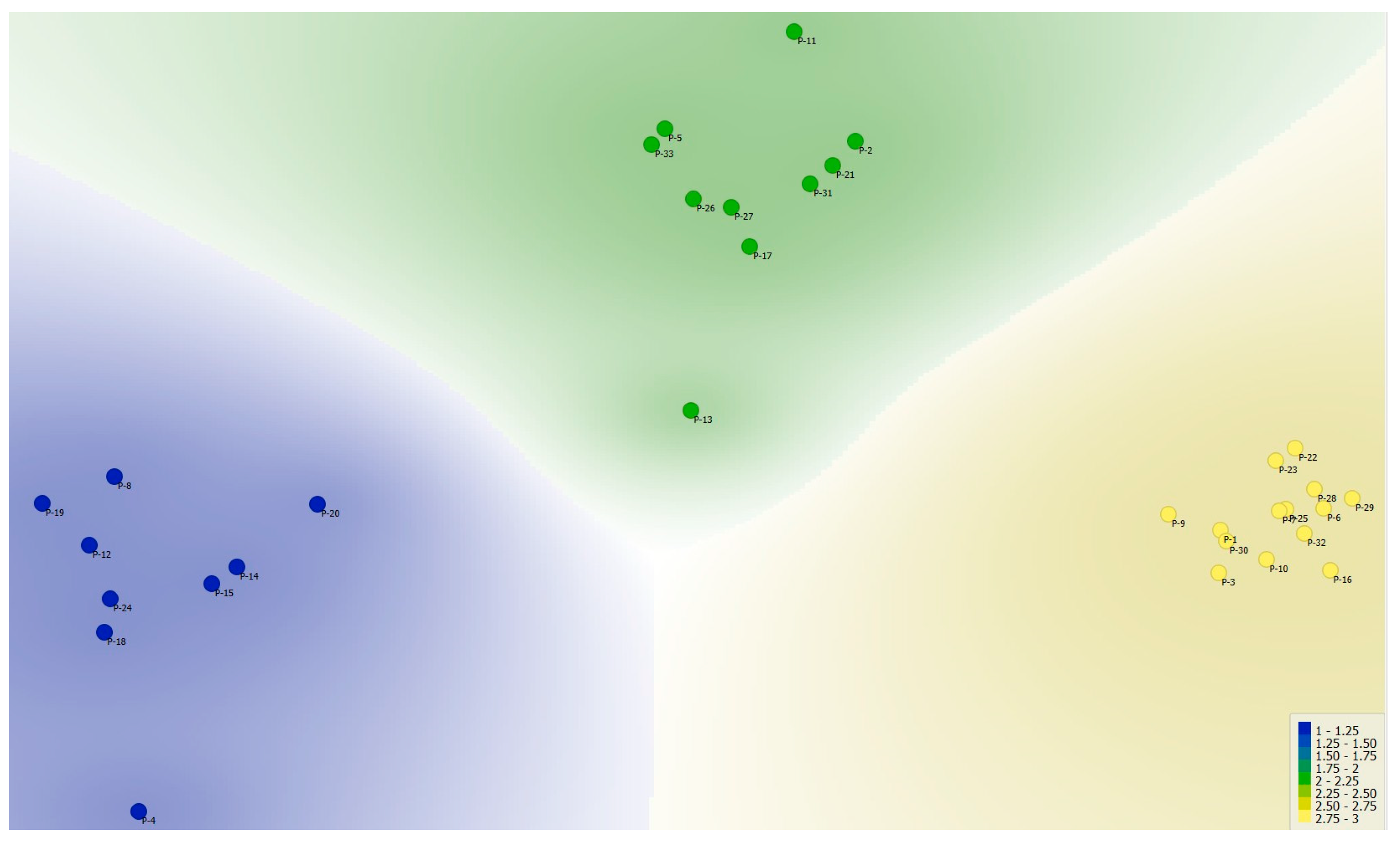
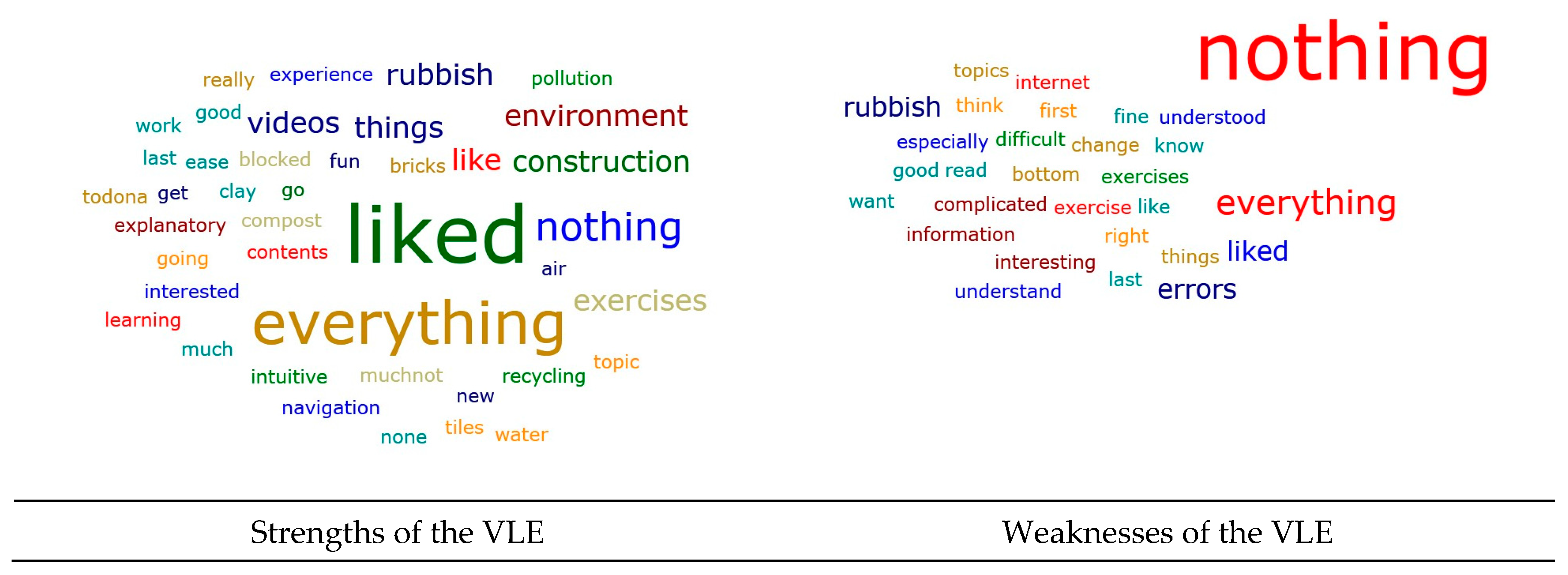
| Thematic Courses | Before n = 33 | After n = 33 | |||||
|---|---|---|---|---|---|---|---|
| M(SD) | M(SD) | df | t | p | d | g | |
| Course 1 | 68.09(21.02) | 82.58(18.75) | 32 | −6.76 | 0.001 * | 0.73 | 0.72 |
| Course 2 | 45.90(20.95) | 72.18(19.06) | 32 | −9.63 | 0.001 * | 1.31 | 1.30 |
| Course 3 | 63.13(14.00) | 81.71(19.29) | 32 | −8.29 | 0.001 * | 1.10 | 1.09 |
| Course 4 | 50.84(12.00) | 64.51(15.97) | 32 | −7.14 | 0.001 * | 0.97 | 0.96 |
| Thematic Courses | Group 1 n = 18 | Group 2 n = 11 | Group 3 n = 4 | ||||
|---|---|---|---|---|---|---|---|
| M(SD) | M(SD) | M(SD) | df | F | p | η2 | |
| Course 1 | 88.46(16.03) | 74.37(19.77) | 76.21(23.32) | (2,32) | 2.31 | 0.12 | 0.13 |
| Course 2 | 76.65(17.55) | 70.80(20.54) | 57.13(18.92) | (2,32) | 1.83 | 0.18 | 0.11 |
| Course 3 | 87.66(18.37) | 74.13(20.68) | 71.71(15.64) | (2,32) | 2.32 | 0.12 | 0.13 |
| Course 4 | 70.86(13.65) | 57.95(16.14) | 52.21(14.79) | (2,32) | 4.20 | 0.03 * | 0.22 |
| Thematic Courses | Group 1 n = 19 | Group 2 n = 10 | Group 3 n = 3 | ||||
|---|---|---|---|---|---|---|---|
| M(SD) | M(SD) | M(SD) | df | F | p | η2 | |
| Course 1 | 82.58(19.23) | 79.54(18.23) | 88.28(28.13) | (2,32) | 0.24 | 0.79 | 0.02 |
| Course 2 | 70.00(19.59) | 76.60(20.80) | 80.88(15.38) | (2,32) | 0.65 | 0.53 | 0.04 |
| Course 3 | 81.00(20.35) | 77.35(20.01) | 89.36(15.74) | (2,32) | 0.42 | 0.66 | 0.03 |
| Course 4 | 69.62(15.16) | 52.76(13.85) | 65.27(13.58) | (2,32) | 4.35 | 0.02 * | 0.24 |
| Thematic Courses | Cluster 1 | Cluster 2 | Cluster 3 | |||
|---|---|---|---|---|---|---|
| n = 14 | n = 10 | n = 9 | df | F | p | |
| Course 1 | 66.91 | 45.28 | 94.85 | (2,30) | 66.75 | 0.001 * |
| Course 2 | 42.55 | 25.84 | 73.34 | (2,30) | 53.48 | 0.001 * |
| Course 3 | 62.23 | 19.09 | 79.48 | (2,30) | 39.86 | 0.001 * |
| Course 4 | 50.16 | 40.18 | 61.16 | (2,30) | 19.27 | 0.001 * |
| Thematic Courses | Cluster 1 | Cluster 2 | Cluster 3 | |||
|---|---|---|---|---|---|---|
| n = 9 | n = 10 | n = 14 | df | F | p | |
| Course 1 | 62.08 | 77.31 | 98.81 | (2,30) | 31.52 | 0.001 * |
| Course 2 | 49.40 | 75.73 | 86.67 | (2,30) | 27.97 | 0.001 * |
| Course 3 | 58.40 | 73.72 | 101.24 | (2,30) | 105.11 | 0.001 * |
| Course 4 | 45.65 | 62.99 | 77.21 | (2,30) | 29.88 | 0.001 * |
| Cluster before | ||||
|---|---|---|---|---|
| Cluster after | 1 | 2 | 3 | Total |
| 1 | 1 | 8 | 5 | 14 |
| 2 | 8 | 2 | 0 | 10 |
| 3 | 0 | 0 | 9 | 9 |
| Total | 9 | 10 | 14 | 33 |
| Items | Mean | Standard Deviation |
|---|---|---|
| 1. Did you understand the content worked with in the VLE? | 2.52 | 0.73 |
| 2. Were the activities clear? | 2.66 | 0.55 |
| 3. Were the activities easy? | 2.45 | 0.75 |
| 4. Did you like the activities? | 2.83 | 0.47 |
| 5. Was the work on the VLE easy? | 2.71 | 0.65 |
| 6. Would you have liked to learn other things in the VLE courses? | 2.71 | 0.60 |
| 7. Was it easy to stop in an activity? | 2.64 | 0.64 |
| 8. Was it easy to move from one activity to another? | 2.64 | 0.67 |
| 9. Was it easy to return to an activity/do an activity again? | 2.74 | 0.58 |
| 10. Did you find the VLE attractive? | 2.88 | 0.42 |
| 11. Did you find the VLE clear? | 2.83 | 0.43 |
| 12. Would you like to change the appearance of the VLE? | 1.74 | 0.92 |
Disclaimer/Publisher’s Note: The statements, opinions and data contained in all publications are solely those of the individual author(s) and contributor(s) and not of MDPI and/or the editor(s). MDPI and/or the editor(s) disclaim responsibility for any injury to people or property resulting from any ideas, methods, instructions or products referred to in the content. |
© 2023 by the authors. Licensee MDPI, Basel, Switzerland. This article is an open access article distributed under the terms and conditions of the Creative Commons Attribution (CC BY) license (https://creativecommons.org/licenses/by/4.0/).
Share and Cite
Sáiz-Manzanares, M.C.; Arranz Barcenilla, C.; Gutiérrez-González, S.; Alameda Cuenca-Romero, L. Usability of a Virtual Learning Environment in Down Syndrome Adult Learning. Sustainability 2023, 15, 16404. https://doi.org/10.3390/su152316404
Sáiz-Manzanares MC, Arranz Barcenilla C, Gutiérrez-González S, Alameda Cuenca-Romero L. Usability of a Virtual Learning Environment in Down Syndrome Adult Learning. Sustainability. 2023; 15(23):16404. https://doi.org/10.3390/su152316404
Chicago/Turabian StyleSáiz-Manzanares, María Consuelo, Cristina Arranz Barcenilla, Sara Gutiérrez-González, and Lourdes Alameda Cuenca-Romero. 2023. "Usability of a Virtual Learning Environment in Down Syndrome Adult Learning" Sustainability 15, no. 23: 16404. https://doi.org/10.3390/su152316404
APA StyleSáiz-Manzanares, M. C., Arranz Barcenilla, C., Gutiérrez-González, S., & Alameda Cuenca-Romero, L. (2023). Usability of a Virtual Learning Environment in Down Syndrome Adult Learning. Sustainability, 15(23), 16404. https://doi.org/10.3390/su152316404






